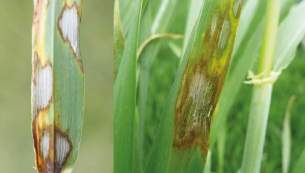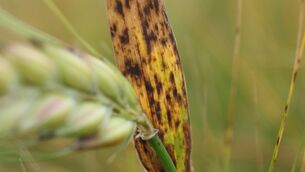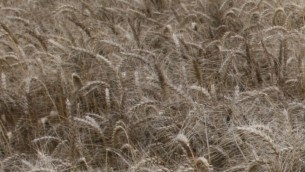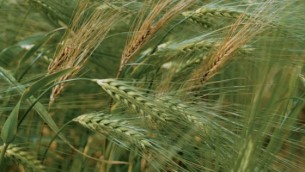Net Blotch
Pyreophora teres
Net blotch (Pyreophora teres) is a common disease of autumn sown barley (much less commonly spring sown barley) which can result in significant yield loss if not controlled. Charateristics net type lesions
give the disease its common name but lesions can also take the form of dark stripes and streaks and when infection is severe in large dead areas of leaf. Infection sources are either seed or crop debris, which is borne out by second year barley crops being likely to carry infection. Net blotch development is favoured by cool, moist conditions.

There are two types of net blotch differentiated by the symptoms: a net form and a spot form. Both occur in NZ but the net form is more common.
Look out for:
- Net like symptoms, especially in 2nd year barley crops
Risk Factors:
- Infected stubble or seed
- Cool, moist conditions
Infection can be seed borne or from infected stubble.
Net blotch favours cool, moist conditions.
Yield losses of 10-30% have been recorded.
Related Pests

Scald
Rhynchosporium secalis
Scald (Rhynchosporium secalis) is a common disease of barley which can result in significant yield loss if not controlled. Scald is favoured by cooler, moist conditions with the initial source of inoculum being infected straw
debris. The first symptoms often appear during winter or early spring, initially as pale greyish lesions which then develop a more straw coloured appearance with a defined dark edge to the lesion.

Ramularia Leaf Spot
Ramularia collo-cygni
Ramularia leaf spot (Ramularia collo-cygni) is a common disease of barley which can result in significant yield loss if not controlled. While both winter and spring planted barley can be affected, the impact of Ramularia is
usually greater on winter planted crops. Ramularia is seed borne and once the fungus has infected the plant it grows within the plant, not producing visible symptoms until around ear emergence. Symptoms consist of small brown lesions which under the right conditions can rapidly increase and coalesce together.

Spot Blotch
Cochiobolus sativus
Spot blotch (Cochiobolus sativus) is an uncommon expression of net blotch, a common disease of autumn sown barley (much less commonly spring sown barley). Spot blotch lesions are dark-brown and
elliptical in shape.

Ear Disease Complex
Ear disease complex is a term used to describe a range of weak pathogens that attack the ear, predominately of wheat, causing the ear to turn black. Due to the black colouration these fungi are often
referred to as sooty moulds. While overall these fungi do not lead to high yield losses they do produce an unsightly crop and they can reduce grain quality. The problem tends to be worse in wet summers and when harvest is delayed.

Loose Smut - Barley
Ustilago tritici
Loose smut of barley is a devastating disease of barley if not controlled by an appropriate seed treatment. Once infected seed is planted the disease
infects the young plant and then grows within the plant unseen until it is time for seed to be produced. Loose smut then replaces healthy developing grain with masses of fungal spores. Infected plants tend to grow taller and mature earlier than healthy plants which allows the fungal spores to fall down onto the open florets of healthy plants. These spores then infect the developing grain and both the fungus and the grain stay alive until they are planted the next season.

Covered Smut - Barley
Ustilago hordei
Covered smut in barley can lead to high yield losses if not controlled by an appropriate seed treatment. Infection takes place from fungal spores present
on the outside of the seed. Contamination takes place at harvest through direct spore transfer from infected to healthy seed. Fungal spores germinate at the same time as the seed and can infect the seedling just before emergence, once plants have emerged they cannot be infected. The fungus grows unseen in the plant entering the head once formed at which point it replaces healthy seed with masses of fungal spores. Infected barley heads can be seen within the crop as greyish brown, stunted ears with shrivelled awns.











